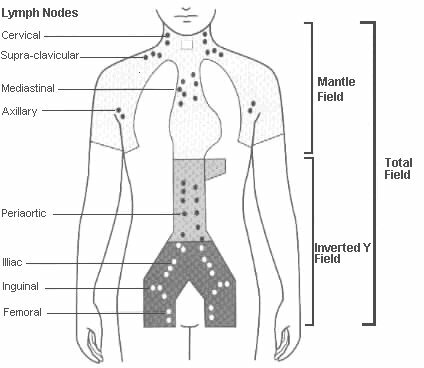

Radiation is often used to treat NHL (and many types of cancer) when there is a localized tumour that can be easily targeted without any other major organs in the way, or for bulky tumours that do not fully respond to chemotherapy.
There may be other reasons why your doctor chooses radiation treatment as well. For example even some of the low grade lymphomas which are normally considered incurable, can be cured if they are truly localized to one site and treated with radiation.
Lymphoma tumours are generally considered to be more sensitive to radiation therapy than many other types of cancer. This makes them good candidates for Radiation therapy.
Before beginning radiation therapy you will probably make a trip to the clinic for a simulation. During this simulation they position you on the table and measure exactly where they will be aiming the radiation. If often involves a CT scan to locate the tumours, and you will probably even get some tattoos. These tattoos (the size of a small pencil dot) are so they can line you up on the treatment table exactly in the right position.
Radiation techniques differ somewhat from those used in the treatment of Hodgkin's disease. The dose of radiation therapy usually varies from 2500 to 5000 cGy and is dependent on factors that include the type of lymphoma, the patient's stage and overall condition, the goal of treatment (curative or palliative), the proximity of sensitive surrounding organs, and whether the patient is being treated with radiation therapy alone or in combination with chemotherapy. Simulators are used to obtain detailed x-rays of patients in the treatment position so that radiation fields can be tailored to conform to the patient's anatomy, and individually shaped protective blocks can be fabricated to shield normal tissues for the individual patient. Radiation treatment fields are tailored to individual patients and are usually limited to involved regions or extended to the immediate adjacent sites. The majority of patients who receive radiation are usually treated on only 1 side of the diaphragm.
Below is a diagram of the typical radiation fields used, and the names of the various lymph node regions.

A newer form of radiation therapy uses protons instead of x-rays or photons. This particular type of radiation therapy allows the radiation to be very precisely focused on the tumour and deliver less radiation to surrounding tissues. This is due to the properties of protons. The exact details of how this works is beyond the scope of this website but the link below to the Oncolink website gives outstanding information for those looking for more. Because the proton therapy machines are prohibitively expensive there are only a handful around the world. They cost in the range of $100 million USD, and that does not include operating costs.
Oncolink proton therapy education modules (excellent information)
Proton therapy Center list of proton therapy sites around the world
From the U.S.A. Environmental Protection Agency
https://www.epa.gov/radiation